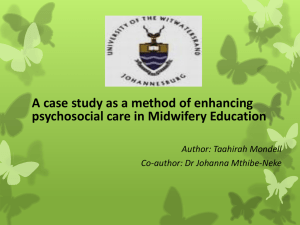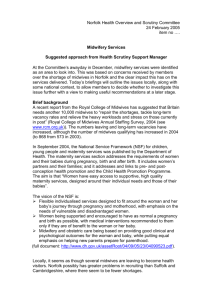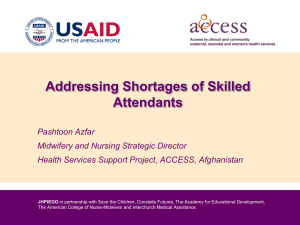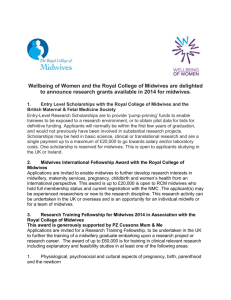Out-of-Hospital Birth Transport Demonstration Project
advertisement
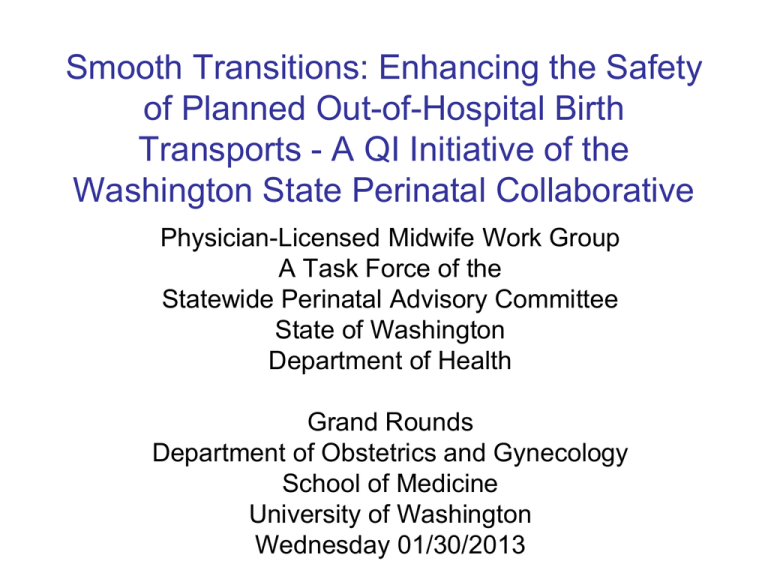
Smooth Transitions: Enhancing the Safety of Planned Out-of-Hospital Birth Transports - A QI Initiative of the Washington State Perinatal Collaborative Physician-Licensed Midwife Work Group A Task Force of the Statewide Perinatal Advisory Committee State of Washington Department of Health Grand Rounds Department of Obstetrics and Gynecology School of Medicine University of Washington Wednesday 01/30/2013 Presentation by • Robert H. Palmer jr, MD, FACOG • Co-Chair, Physician-Licensed Midwife Work Group • OB Hospitalist, Obstetrix Medical Group • Swedish Medical Center, Seattle & Issaquah • bobpalmermd@gmail.com • 360.531.2525 cell Disclosures • The speaker has no conflicts of interest to disclose. Learning Objectives • Understand the categories of midwives in WA state • Understand the training and experience prior to licensure of Licensed Midwives • Understand the scope of out-of-hospital births in WA state • Understand the scope of practice of LM’s • Understand the liability issues involving LM’s • Understand how to begin to streamline the process of planned out-of-hospital birth transports Three Categories of Midwives Recognized in Washington State • Lay Midwives • Licensed Midwives (LM) • LM’s may also hold a national credential of Certified Professional Midwife (CPM) • Certified Nurse Midwives (CNM), in New York State, Certified Midwives (CM) Lay Midwives • Recognized under WA law since 1917 • Generally, any person, usually a woman, usually age 18 or over, may attend a woman giving birth or assist with labor and delivery • May not advertise, have business cards, letterhead, or take any payment in cash, trade, or goods-in-kind for the midwifery services rendered Licensed Midwives • WA first licensed midwives in 1980 • 2012: 109 LM in WA • 2010: delivered approx. 2,295 babies (2.7% WA births are with LM’s. Up from 1.9% in 2006) • 12%-25% (275-574) of women who begin the process of a planned out-of-hospital birth require transport to an acute-care hospital either during labor, or during the postpartum period Hospital Transfers • Intrapartum transfer rates range from 12-20% • 75-80% of transfers are primiparas • 51% are for prolonged labor, pain relief or exhaustion • 96.5% are non-urgent • 50-66% deliver vaginally • 1.3% of mothers were transferred immediately postpartum, primarily for hemorrhage and retained placenta • 0.7% of newborns were transferred after birth, primarily for respiratory problems 2010 WA Births • • • • • Total Births Hospitals Birth Centers Home Other 86,510 83,972 866 1,616 56 97.1% 1.0% 1.9% 0% • • • • MD/DO CNM LM Other 74,944 7,935 2,295 1,336 86.6% 9.2% 2.7% 1.5% Out-of-Hospital Births in WA • In 2010, 2.9% of WA’s births occurred in an out-of-hospital setting (N=2,538) • 64% at home (N=1,616) • 34% in licensed freestanding birth centers (N=866) • 2% in other locations (N=56) • 90% of out-of-hospital births in WA are attended by LM’s Seattle Midwifery School • Founded in 1978 by a group of lay midwives • Three-year program for direct-entry midwives • Accredited – State of Washington, Department of Health – Midwifery Education Accreditation Council • Formerly the leading educator of LM’s in WA • Merged with Bastyr University in March 2010 and now a Master’s-level program LM Educational Tracks • Complete a 3-year education from a WA state-approved school, including attending a minimum of 100 births, or • Graduate from an equivalent program from another state or country, or • Present documentation of completion of “equivalent subject matter...and a number of clinical managements under a (qualified) preceptor,” and • Pass an examination provided to the state by the North American Registry of Midwives (NARM), www.narm.org Licensed Midwives • 77 acute-care hospitals in WA who are licensed to provide obstetrical services • Currently, there are two licensed midwives with privileges to deliver babies in WA (Morton & Coupeville) • LM’s plan their births in the woman’s home, or in a licensed freestanding birthing center • 6 licensed freestanding birth centers in the greater Seattle area where the births are attended by LM’s • 13 licensed freestanding birth centers in WA state Licensed Midwives May • • • • • • • • • Start IV fluids Maintain saline or heparin locks Administer: Prophylactic ophthalmic medication Postpartum oxytocin Vitamin K Rh-immune globulin Local anesthesia for laceration repair Magnesium sulfate for prevention of maternal seizures pending transport Licensed Midwives May Administer • Epinephrine for use in maternal anaphylaxis pending transport • Terbutaline for non-reassuring fetal heart tones and/or cord prolapse pending transport • Antibiotics for intrapartum prophylaxis of Group B streptococcus • Anti-hemorrhagic drugs to control postpartum hemorrhage, such as misoprostol per rectum, methylergonovine maleate (oral or IM), prostaglandin15-methyl F2 alpha (Hemabate) • MMR vaccine to non-immune mothers postpartum • HBIG and HBV for neonates born to hepatitis B-positive mothers Licensed Midwives • Licensed by the State of Washington Department of Health • Regulated by the State of Washington Department of Health, Midwife Advisory Committee • Disciplined by the State of Washington Department of Health, Health Services Quality Assurance Program Licensed Midwives • Professional liability insurance is available in WA state to LM’s through the Joint Underwriting Association administered by Washington Casualty Company, Redmond, WA, www.juawashington.com • LM’s are reimbursed for obstetrical services by the state Medicaid program (Department of Social and Health Services, DSHS) and most private insurers Professional Association • Midwives Association of WA State (MAWS) • Voluntary, 82 of 109 (75%) LM’s are members • www.washingtonmidwives.org • MAWS establishes standards of practice , provides continuing education, advocacy, and legislative support Quality Management Program • MAWS maintains a QMP with state-protected, confidential peer-review and incident review; all professional MAWS members are required to participate in the QMP • LM’s are required to self-report sentinel events within 14 days • Anyone may submit a report (patient, family members or other healthcare providers) • Review includes recommendations and may include a report to the Department of Health, pursuant to state law Liability Insurance • LM’s may choose to obtain liability insurance through a state-mandated program, the Joint Underwriting Association (JUA), Redmond, WA • www.washingtonjua.com • 68 or the 109 (62%) LM’s in WA are insured by the JUA • Some of the 41 LM’s not insured through the JUA may have purchased other coverage • All 13 licensed freestanding birth centers in WA have liability coverage through the JUA Professional Liability Issues • Three major professional liability insurers in WA: Physicians Insurance, Medical Protective, The Doctors Company, all • Ask their insureds not to form formal relationships with LM’s (which might be interpreted as a “loaning” of the physician’s liability limits to the LM) • Cover their insureds when their insureds are on emergency obstetrical call and are asked to care for any woman brought to the hospital for obstetrical care, including those being transported under a LM’s care Professional Liability Issues • In addition, Physicians Insurance allows their insureds to respond to an outpatient consultation request from a LM as they would respond to a consultation request from any other licensed health-care professional LM/OB Roles • The midwifery client is best served by discussion in the prenatal course about possible outcomes, need for transfer • The midwifery client is best served by discussion speaking about OB physicians and hospitals in positive terms • The midwifery client is best served by preparing her for what services she will need in the hospital LM/OB Roles • The midwifery client is best served when transferred in a timely manner, with complete prenatal records that are selfexplanatory • The hospital staff serves the patient best by quickly and smoothly receiving the patient, getting her admitted to the labor and delivery unit, and notifying the on-call OB physician of the admission LM/OB Roles • The OB MD serves the patient best by providing competent, kind, compassionate, and timely care • The OB MD serves the patient best by being non-judgmental about the patient’s planned out-of-hospital birth • The OB MD serves the patient best by treating the LM with respect LM/OB Roles • The OB MD serves the patient best by returning the patient to the LM with a discharge summary when the patient is discharged from the hospital and follow-up care with the LM is appropriate • The LM serves the patient best by relinquishing control of the care of her client to the hospital staff LM/OB Roles • The LM serves the patient best by being supportive of her client and being supportive of the hospital staff • All providers must create a peaceful, supportive, caring environment within the hospital setting to provide the care the mother and her baby came to the hospital to receive Smooth Transitions • Created in September 2005 • Need to improve the process of out-of-hospital birth transport • Form a pre-hospital perinatal transport committee, composed of • Local licensed midwives • Obstetricians • Emergency Department Physician & Nursing Leadership • Obstetrical Nurse Manager • Obstetrical Charge Nurses • Appropriate Hospital Administrators Pre-Hospital Perinatal Transport Committee • Parties getting acquainted with each other • Learn each other’s needs when a transport becomes necessary • Agree upon communication pathways • Hospital staff defines needs in terms of necessary information, how that information is to be provided and to whom Pre-Hospital Perinatal Transport Committee • LM and OB MD need to understand how to transfer the patient’s care, and • How to return the patient to the LM upon discharge from the hospital • Communication includes understanding the prenatal record system of the LM and for the OB MD (or pediatrician) to provide a discharge summary to the LM Pre-Hospital Perinatal Transport Committee • This committee is encouraged to develop an evaluation process that surveys satisfaction from the patient, the LM, the nursing staff and the medical staff involved • This evaluation form should solicit examples of what went well/smoothly, and what could use improvement • Twice a year (at least) this committee should meet and recognize successes and look for ways of improving the process Pre-Hospital Perinatal Transport Committee • At year end, the hospital committee is encouraged to make a report to the Smooth Transitions Project Coordinator about their experience with the Smooth Transitions program, which in turn would share the report with the Statewide Perinatal Advisory Committee • This report (and all survey instruments) should be free of any patient or provider identifiers For More Information • WA State Perinatal Collaborative: www.waperinatal.org • Smooth Transitions Project Coordinator: Melissa Hughes, LM, 206.697.2226 SmoothTransitionsPC@gmail.com • Bob Palmer, MD, 360.531.2525 bobpalmermd@gmail.com
![Letter to MPs re: maternal mental health report Dear [Name of MP] I](http://s3.studylib.net/store/data/006839335_1-7d7b3127aade7ad6d126565942ce75c1-300x300.png)
